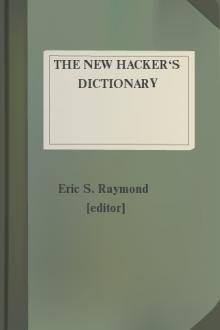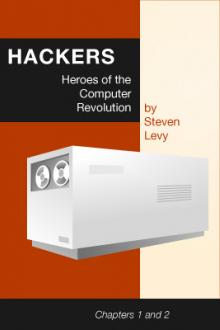The New Hacker's Dictionary by Eric S. Raymond (romantic novels to read .txt) 📕

- Author: Eric S. Raymond
- Performer: 0262680920
Book online «The New Hacker's Dictionary by Eric S. Raymond (romantic novels to read .txt) 📕». Author Eric S. Raymond
ASCIIbetical order /as'kee-be'-t*-kl or'dr/ adj.,n.
Used to indicate that data is sorted in ASCII collated order rather
than alphabetical order. This lexicon is sorted in something close to
ASCIIbetical order, but with case ignored and entries beginning with
non-alphabetic characters moved to the end. "At my video store, they
used their computer to sort the videos into ASCIIbetical order, so I
couldn't find `"Crocodile" Dundee' until I thought to look before
2001' and48 HRS.'!"
Node:astroturfing, Next:[664]atomic, Previous:[665]ASCIIbetical order,
Up:[666]= A =
astroturfing n.
The use of paid shills to create the impression of a popular movement,
through means like letters to newspapers from soi-disant `concerned
citizens', paid opinion pieces, and the formation of grass-roots
lobbying groups that are actually funded by a PR group (astroturf is
fake grass; hence the term). This term became common among hackers
after it came to light in early 1998 that Microsoft had attempted to
use such tactics to forestall the U.S. Department of Justice's
antitrust action against the company.
This backfired horribly, angering a number of state attorneys-general
enough to induce them to go public with plans to join the Federal
suit. It also set anybody defending Microsoft on the net for the
accusation "You're just astroturfing!".
Node:atomic, Next:[667]attoparsec, Previous:[668]astroturfing,
Up:[669]= A =
atomic adj.
[from Gk. `atomos', indivisible] 1. Indivisible; cannot be split up.
For example, an instruction may be said to do several things
`atomically', i.e., all the things are done immediately, and there is
no chance of the instruction being half-completed or of another being
interspersed. Used esp. to convey that an operation cannot be screwed
up by interrupts. "This routine locks the file and increments the
file's semaphore atomically." 2. [primarily techspeak] Guaranteed to
complete successfully or not at all, usu. refers to database
transactions. If an error prevents a partially-performed transaction
from proceeding to completion, it must be "backed out," as the
database must not be left in an inconsistent state.
Computer usage, in either of the above senses, has none of the
connotations that `atomic' has in mainstream English (i.e. of
particles of matter, nuclear explosions etc.).
Node:attoparsec, Next:[670]AUP, Previous:[671]atomic, Up:[672]= A =
attoparsec n.
About an inch. `atto-' is the standard SI prefix for multiplication by
10^(-18). A parsec (parallax-second) is 3.26 light-years; an
attoparsec is thus 3.26 * 10^(-18) light years, or about 3.1 cm (thus,
1 attoparsec/[673]microfortnight equals about 1 inch/sec). This unit
is reported to be in use (though probably not very seriously) among
hackers in the U.K. See [674]micro-.
Node:AUP, Next:[675]autobogotiphobia, Previous:[676]attoparsec,
Up:[677]= A =
AUP /A-U-P/
Abbreviation, "Acceptable Use Policy". The policy of a given ISP which
sets out what the ISP considers to be (un)acceptable uses of its
Internet resources.
Node:autobogotiphobia, Next:[678]automagically, Previous:[679]AUP,
Up:[680]= A =
autobogotiphobia /aw'toh-boh-got`-foh'bee-/
n. See [681]bogotify.
Node:automagically, Next:[682]avatar, Previous:[683]autobogotiphobia,
Up:[684]= A =
automagically /aw-toh-maj'i-klee/ adv.
Automatically, but in a way that, for some reason (typically because
it is too complicated, or too ugly, or perhaps even too trivial), the
speaker doesn't feel like explaining to you. See [685]magic. "The
C-INTERCAL compiler generates C, then automagically invokes cc(1) to
produce an executable."
This term is quite old, going back at least to the mid-70s in jargon
and probably much earlier. The word `automagic' occurred in
advertising (for a shirt-ironing gadget) as far back as the late
1940s.
Node:avatar, Next:[686]awk, Previous:[687]automagically, Up:[688]= A =
avatar n. Syn.
[in Hindu mythology, the incarnation of a god] 1. Among people working
on virtual reality and [689]cyberspace interfaces, an avatar is an
icon or representation of a user in a shared virtual reality. The term
is sometimes used on [690]MUDs. 2. [CMU, Tektronix] [691]root,
[692]superuser. There are quite a few Unix machines on which the name
of the superuser account is avatar' rather thanroot'. This quirk
was originated by a CMU hacker who found the terms `root' and
superuser' unimaginative, and thoughtavatar' might better impress
people with the responsibility they were accepting.
Node:awk, Next:[693]B5, Previous:[694]avatar, Up:[695]= A =
awk /awk/
n. [Unix techspeak] An interpreted language for massaging text datadeveloped by Alfred Aho, Peter Weinberger, and Brian Kernighan (the
name derives from their initials). It is characterized by C-like
syntax, a declaration-free approach to variable typing and
declarations, associative arrays, and field-oriented text processing.
See also [696]Perl. 2. n. Editing term for an expression awkward to
manipulate through normal [697]regexp facilities (for example, one
containing a [698]newline). 3. vt. To process data using awk(1).
Node:= B =, Next:[699]= C =, Previous:[700]= A =, Up:[701]The Jargon
Lexicon
= B =
[702]B5:
[703]back door:
[704]backbone cabal:
[705]backbone site:
[706]backgammon:
[707]background:
[708]backreference:
[709]backronym:
[710]backspace and overstrike:
[711]backward combatability:
[712]BAD:
[713]Bad and Wrong:
[714]Bad Thing:
[715]bag on the side:
[716]bagbiter:
[717]bagbiting:
[718]baggy pantsing:
[719]balloonian variable:
[720]bamf:
[721]banana label:
[722]banana problem:
[723]banner ad:
[724]banner site:
[725]barn:
[726]batbelt:
[727]Befunge:
[728]BI:
[729]binary four:
[730]bandwidth:
[731]bang:
[732]bang on:
[733]bang path:
[734]banner:
[735]bar:
[736]bare metal:
[737]barf:
[738]barfmail:
[739]barfulation:
[740]barfulous:
[741]barney:
[742]baroque:
[743]BASIC:
[744]batch:
[745]bathtub curve:
[746]baud:
[747]baud barf:
[748]baz:
[749]bazaar:
[750]bboard:
[751]BBS:
[752]BCPL:
[753]beam:
[754]beanie key:
[755]beep:
[756]beige toaster:
[757]bells and whistles:
[758]bells whistles and gongs:
[759]benchmark:
[760]Berkeley Quality Software:
[761]berklix:
[762]Berzerkeley:
[763]beta:
[764]BFI:
[765]bible:
[766]BiCapitalization:
[767]B1FF:
[768]biff:
[769]Big Gray Wall:
[770]big iron:
[771]Big Red Switch:
[772]Big Room:
[773]big win:
[774]big-endian:
[775]bignum:
[776]bigot:
[777]bit:
[778]bit bang:
[779]bit bashing:
[780]bit bucket:
[781]bit decay:
[782]bit rot:
[783]bit twiddling:
[784]bit-paired keyboard:
[785]bitblt:
[786]BITNET:
[787]bits:
[788]bitty box:
[789]bixen:
[790]bixie:
[791]black art:
[792]black hole:
[793]black magic:
[794]Black Screen of Death:
[795]Black Thursday:
[796]blammo:
[797]blargh:
[798]blast:
[799]blat:
[800]bletch:
[801]bletcherous:
[802]blink:
[803]blinkenlights:
[804]blit:
[805]blitter:
[806]blivet:
[807]bloatware:
[808]BLOB:
[809]block:
[810]block transfer computations:
[811]Bloggs Family:
[812]blow an EPROM:
[813]blow away:
[814]blow out:
[815]blow past:
[816]blow up:
[817]BLT:
[818]Blue Book:
[819]blue box:
[820]Blue Glue:
[821]blue goo:
[822]Blue Screen of Death:
[823]blue wire:
[824]blurgle:
[825]BNF:
[826]boa:
[827]board:
[828]boat anchor:
[829]bob:
[830]bodysurf code:
[831]BOF:
[832]BOFH:
[833]bogo-sort:
[834]bogometer:
[835]BogoMIPS:
[836]bogon:
[837]bogon filter:
[838]bogon flux:
[839]bogosity:
[840]bogotify:
[841]bogue out:
[842]bogus:
[843]Bohr bug:
[844]boink:
[845]bomb:
[846]bondage-and-discipline language:
[847]bonk/oif:
[848]book titles:
[849]boot:
[850]Borg:
[851]borken:
[852]bot:
[853]bot spot:
[854]bottom feeder:
[855]bottom-up implementation:
[856]bounce:
[857]bounce message:
[858]boustrophedon:
[859]box:
[860]boxed comments:
[861]boxen:
[862]boxology:
[863]bozotic:
[864]BQS:
[865]brain dump:
[866]brain fart:
[867]brain-damaged:
[868]brain-dead:
[869]braino:
[870]branch to Fishkill:
[871]bread crumbs:
[872]break:
[873]break-even point:
[874]breath-of-life packet:
[875]breedle:
[876]Breidbart Index:
[877]bring X to its knees:
[878]brittle:
[879]broadcast storm:
[880]brochureware:
[881]broken:
[882]broken arrow:
[883]BrokenWindows:
[884]broket:
[885]Brooks's Law:
[886]brown-paper-bag bug:
[887]browser:
[888]BRS:
[889]brute force:
[890]brute force and ignorance:
[891]BSD:
[892]BSOD:
[893]BUAF:
[894]BUAG:
[895]bubble sort:
[896]bucky bits:
[897]buffer chuck:
[898]buffer overflow:
[899]bug:
[900]bug-compatible:
[901]bug-for-bug compatible:
[902]bug-of-the-month club:
[903]buglix:
[904]bulletproof:
[905]bullschildt:
[906]bum:
[907]bump:
[908]burble:
[909]buried treasure:
[910]burn-in period:
[911]burst page:
[912]busy-wait:
[913]buzz:
[914]BWQ:
[915]by hand:
[916]byte:
[917]byte sex:
[918]bytesexual:
[919]Bzzzt! Wrong.:
Node:B5, Next:[920]back door, Previous:[921]awk, Up:[922]= B =
B5 //
[common] Abbreviation for "Babylon 5", a science-fiction TV series as
revered among hackers as was the original Star Trek.
Node:back door, Next:[923]backbone cabal, Previous:[924]B5, Up:[925]=
B =
back door n.
[common] A hole in the security of a system deliberately left in place
by designers or maintainers. The motivation for such holes is not
always sinister; some operating systems, for example, come out of the
box with privileged accounts intended for use by field service
technicians or the vendor's maintenance programmers. Syn. [926]trap
door; may also be called a `wormhole'. See also [927]iron box,
[928]cracker, [929]worm, [930]logic bomb.
Historically, back doors have often lurked in systems longer than
anyone expected or planned, and a few have become widely known. Ken
Thompson's 1983 Turing Award lecture to the ACM admitted the existence
of a back door in early Unix versions that may have qualified as the
most fiendishly clever security hack of all time. In this scheme, the
C compiler contained code that would recognize when the `login'
command was being recompiled and insert some code recognizing a
password chosen by Thompson, giving him entry to the system whether or
not an account had been created for him.
Normally such a back door could be removed by removing it from the
source code for the compiler and recompiling the compiler. But to
recompile the compiler, you have to use the compiler -- so Thompson
also arranged that the compiler would recognize when it was compiling
a version of itself, and insert into the recompiled compiler the code
to insert into the recompiled `login' the code to allow Thompson entry
-- and, of course, the code to recognize itself and do the whole thing
again the next time around! And having done this once, he was then
able to recompile the compiler from the original sources; the hack
perpetuated itself invisibly, leaving the back door in place and
active but with no trace in the sources.
The talk that suggested this truly moby hack was published as
"Reflections on Trusting Trust", "Communications of the ACM 27", 8
(August 1984), pp. 761-763 (text available at
[931]http://www.acm.org/classics). Ken Thompson has since confirmed
that this hack was implemented and that the Trojan Horse code did
appear in the login binary of a Unix Support group machine. Ken says
the crocked compiler was never distributed. Your editor has heard two
separate reports that suggest that the crocked login did make it out
of Bell Labs, notably to BBN, and that it enabled at least one
late-night login across the network by someone using the login name
`kt'.
Node:backbone cabal, Next:[932]backbone site, Previous:[933]back door,
Up:[934]= B =
backbone cabal n.
A group of large-site administrators who pushed through the [935]Great
Renaming and reined in the chaos of [936]Usenet during most of the
1980s. During most of its lifetime, the Cabal (as it was sometimes
capitalized) steadfastly denied its own existence; it was almost
obligatory for anyone privy to their secrets to respond "There is no
Cabal" whenever the existence or activities of the group were
speculated on in public.
The result of this policy was an attractive aura of mystery. Even a
decade after the cabal [937]mailing list disbanded in late 1988
following a bitter internal catfight, many people believed (or claimed
to believe) that it had not actually disbanded but only gone deeper
underground with its power intact.
This belief became a model for various paranoid theories about various
Cabals with dark nefarious objectives beginning with taking over the
Usenet or Internet. These paranoias were later satirized in ways that
took on a life of their own. See [938]Eric Conspiracy for one example.
See [939]NANA for the subsequent history of "the Cabal".
Node:backbone site, Next:[940]backgammon, Previous:[941]backbone
cabal, Up:[942]= B =
backbone site n.,obs.
Formerly, a key Usenet and email site, one that processes a large
amount of third-party traffic, especially if it is the home site of
any of the regional coordinators for the Usenet maps. Notable backbone
sites as of early 1993, when





Comments (0)